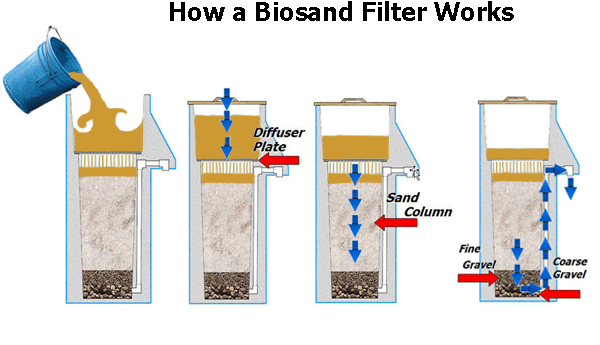Our Biosand Filters
Since 2006 Water for Cambodia has been building and installing biosand water filters in rural villages of Cambodia. These filters are household units that produce clean water directly from contaminated sources. Polluted water is poured in the top, filtered through the sand and gravel layers and within minutes clean drinking water pours from the spout. Filtered water looks and tastes good, an advantage over well water where high iron content has an offensive taste and color. One filter can produce enough clean water for a family of 5-8 for many years.
According to a summary of laboratory and field studies for biosand filters conducted by the Center for Affordable Water and Sanitation Technology (CAWST.org) they remove the following from contaminated water:
- up to 98.5% of bacteria
- up to 99.9% of protozoa
- up to 95% of turbidity
- 90-95% of iron
For more information on the technical aspects of the biosand filter visit www.cawst.org.

Biosand Filter Construction
Each filter is constructed of a concrete body 3' tall and a foot square filled with layers of gravel and sand (see schematic above). Source water is poured onto a diffuser plate at the top of the filter to prevent disturbing the top layer of sand. After passing through the sand and gravel, the now clean water travels through the copper pipe and out the spout using the force of gravity alone. There are no moving or mechanical parts to break.
The key to the effectiveness of the filter is the biological zone which naturally forms on the sand surface. This layer consumes harmful bacteria and other pathogens. As the water passes through the sand layer larger contaminants (e.g. parasites) are trapped and others (e.g. viruses, certain organic compounds) are attached to the particles of sand, a process called adsorption. In the lower layers of the filter where oxygen levels diminish organisms die a natural death.
A family receiving a biosand filter pays a nominal fee and is actively involved in the installation giving them a vested interest in maintaining them. Also, instruction in filter operation and maintenance as well as basic education in hygiene and sanitation are provided. Biosand filters in general require very little maintenance (occasional stirring up of the top few inches of sand and scooping the suspended sediment) and are still functioning effectively more than 10 years after installation. Filters are manufactured locally using local materials.